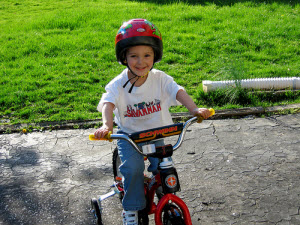 Updated June, 2012
Updated June, 2012
Karen Axon can’t wait for the arrival of warmer weather and sunnier days so her family can resume their favorite summer pastime: bike riding.
On summer days, Axon, her husband, Troy, and their two boys frequently escape from their Bothell home for a riding adventure to the beach or the park. “Family bike riding is so much fun,” says Axon. “It gives us an opportunity to work out and entertain the kids at the same time. It also sets a good example for our boys on how to have fun and be active at the same time.” Bike riding offers good exercise and a fun way to explore the community. By taking a few precautions, you can ensure that your family’s excursion is safe.
Wear a helmet
Every member of your family should be wearing a bike helmet that meets or exceeds the U.S. Consumer Product Safety Commission standards. Wearing a helmet is not only smart, it’s the law in King, Pierce and Snohomish counties. “The risk of serious injury and death is related to head injury,” says Dr. Fred Rivara, division chief of pediatrics at Seattle Children’s Hospital. “Everyone should always be helmeted.”
In 1989, Rivara, Dr. Robert S. Thompson and Diane Thompson, M.S., conducted a landmark study determining the effectiveness of wearing a bike helmet. “We did the bedrock research that demonstrated bike helmets really work,” says Dr. Thompson, director emeritus of the Department of Preventive Care at Seattle’s Group Health. The study found that cyclists wearing bike helmets had a much lower occurrence of head injuries. “Wearing helmets decreases the risk of brain injury by 85 to 88 percent,” says Dr. Thompson.
Infants should be about 1 year of age before they wear a helmet or travel on a bike. “They have to be able to sit up well and have the neck strength to support a helmet,” recommends Diane Thompson, a retired epidemiologist from Harborview’s Injury Prevention Research Center.
A proper fit directly correlates to the effectiveness of the bike helmet. “The helmet should be level and snug,” says Kat Sweet, youth program coordinator for the Cascade Bicycle Club. “If it slides around, you should try a smaller helmet, insert thicker pads or adjust the chin strap and buckles under the ears.”
Sweet organizes bicycle-basics clinics in area schools and teaches children to utilize the “eyes, ears, mouth” check to ensure a snug fit.
• Eyes: You should see the edge of your helmet when you look up.
• Ears: The straps should form a “Y” under your ear lobes.
• Mouth: The chin strap should be snug enough so that when you yawn, the helmet pulls down on top of your head
Sweet says that sharing this principle with older children can help them become responsible for their own safety.
Children may resist wearing helmets, but experts say parents should make this a nonnegotiable rule in their household. Initially, Axon’s 6-year-old son, Adrian, was less than thrilled to wear his helmet, but Axon remained consistent. “We all wear helmets every time we go riding,” she says. “It was hard to keep Adrian’s helmet on in the beginning, but we decided to deal with his complaining and crying for a couple of rides because we knew he would have to get used to it.”
Diane Thompson mentions that the most positive way to reinforce helmet usage is to wear one yourself. “Parents can make a big impact by wearing a helmet and modeling good behavior,” she says. “It’s also a good idea to get your child in the habit of wearing a helmet when riding tricycles or scooters.”
Riding with children
There are two popular choices for bike travel with children who don’t ride independently: a bike-mounted seat and a bike trailer.
Bike-mounted seats are easier to use and less expensive than trailers, explains Leif Thorsen, store manager of Gregg’s Cycles at Green Lake. “The downside of these seats is that the child will go with the bike if you fall,” he says.
Bike trailers have a higher price tag, but they are more versatile. Most models can convert into strollers and have a higher weight capacity. Thorsen generally recommends a bike trailer because it’s more stable and won’t tip over if the bike falls. “The child won’t have impact with the ground when the bike falls, but there are still risks associated with pulling a trailer,” says Thorsen. “The trailer is lower to the ground, so visibility is crucial.” Thorsen advises parents to equip trailers with a flag and reflectors.
As with any other outing you undertake with children, planning ahead and packing a few extra items will keep your family safe and comfortable.
Axon’s list of necessities includes a tire pump, sunscreen, sunglasses, appropriate clothing and a cell phone for emergencies. “By using the bike trailer, we have plenty of room to bring along anything we think we might need,” says Axon. “You’ll always find extra snacks and lots of cool water for us and the kids.”
Thorsen reminds cyclists to make sure their bike is in optimal operating condition before every ride. “Fill your tires and inspect your brakes,” he says. “Consider your bike as you would your car: Routine maintenance keeps it running.”
Hitting the trail
Bicycle trails abound in the Puget Sound area. Trails are a great place to bike as a family because you’re away from the inherent dangers of street traffic. “Trail riding is a safer option because the risk is much less than riding in traffic,” says Rivara.
Many trails in our area are family friendly, but make sure you use good bike etiquette. “Follow posted trail rules, sound a bell or use your voice to alert bikers when you’re passing, and be aware that there are lots of people biking with multiple ability levels,” advises Thorsen. “A bike ride is an excellent way to spend an afternoon and even more fun when you make safety a top priority.”
Abbey McGee is an Everett-based freelance writer and mother of four children ages 7, 5, 2 and 2 months.
Family-friendly bike routes
Burke-Gilman Trail /Sammamish River Trail
The Burke-Gilman Trail begins in Seattle’s Fremont neighborhood and runs northwest along Lake Washington for more than 15 miles. At Bothell Landing, it joins the Sammamish River Trail and runs another 10-plus miles to Redmond’s Marymoor Park. Parts of the paved trail are heavily used, so be aware of other riders and trail rules.
Green Lake Park
Seattle’s Green Lake Park has nearly three miles of flat, paved trail for families to enjoy. The park has a designated path for bikes and other wheeled users, separate from a gravel path for walkers and joggers.
Interurban Trail
Snohomish County’s Interurban Trail runs from Everett Mall into the city of Lynnwood. While most of the 15.1-mile trail is designated, paved trail, there are some places where the trail runs on the road shoulder.
Centennial Trail
The popular Centennial Trail links Snohomish County to Skagit County and offers families 23 miles of trail between Snohomish and Bryant.
The Foothills Trail
Foothills Trail includes nearly 17 miles of wide, paved trail southeast of Sumner. The county plans to expand the trail in the future.
For additional route information and detailed city and county maps, please visit the Cascade Bicycle Club .
Additional resources
The Washington State Department of Transportation lists important rules of the road for bicyclists:
www.wsdot.wa.gov/bike/Safety_Tips.htm
Seattle’s Cascade Bicycle Club Education Foundation provides specific safety tips for infants and toddlers:
www.cbcef.org/infants_toddlers.html
The foundation also offers more general safety resources:
www.cbcef.org/materials.html
Visit the Bicycle Helmet Safety Institute in Arlington, Va., for anything you ever wanted to know about bike helmets:
www.helmets.org
With locations throughout the Puget Sound region, Gregg’s Cycles (www.greggscycles.com ) and REI (www.rei.com ) can outfit your family with bike helmets, equipment and gear.









